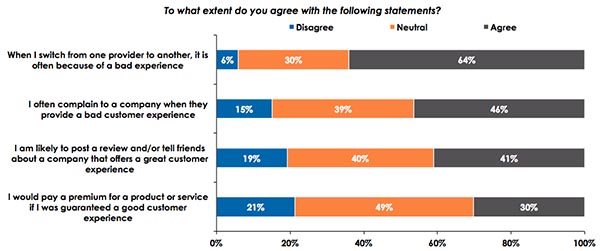- Rather than lumping people into rigid categories based on age or other demographics, providers must develop an omni-channel strategy that treats all customers as unique individuals.
- Nearly two-thirds of consumers reported that when they switched providers, it was due to a bad experience.
- For their part, savvy enterprises have come to understand that the customer experience can have a dramatic effect on retention rates.
By Eve Padula
Introduction
Consumers are more informed and empowered than ever before, and their preferences are in a constant state of flux. Providers of transactional communications (e.g., bills, statements, policy notices, and other business-critical communications) must continually reinvent themselves to keep up with these changing preferences and work to effectively deliver their messages. In many cases, the method of delivery can be just as important as the transactional content itself. Above all, today’s consumers are demanding a say in the way that their providers communicate with them. They want control over the communications they receive, the format of those communications, and the overall experience of dealing with the providers of their transactional documents. This document provides top-level data points from Keypoint Intelligence – InfoTrends’ most recent transactional communications survey to underscore the importance of choice in delivering a positive customer experience.
One Size Does Not Fit All!
Although an increasing number of consumers across all demographics are embracing digital, print remains a key communication channel. In today’s complex communication environment, no single channel will deliver the experience that an entire customer base—or even an individual customer—demands. Consider the following statistics from InfoTrends’ 2019 transactional communications research:
- Over three-quarters of total consumer respondents agree that they want to decide which channels their providers use to communicate with them.
- Another 55% of consumers want to decide what information is relevant to them and have only that information regularly reported.
Rather than lumping consumers into rigid categories based on age or other demographics, savvy communication providers must develop an omnichannel strategy that treats all customers as unique individuals. To accomplish this, businesses must invest in technology platforms and/or outsourcing partnerships that can be scaled to support a long-term vision for success. Regardless of whether they are printed or digital, all communications must be timely, relevant, and customized to the recipient. Furthermore, each customer touchpoint should be maximized to improve the customer experience.
Communication providers must accommodate consumers’ ever-evolving preferences, because doing so is vital to a positive customer experience. As shown in the figure below, nearly two-thirds of consumers reported that when they switched providers, it was due to a bad experience. In addition, 46% often complained to a company that provided a bad customer experience. At the same time, a positive experience can prompt action too—41% of respondents commonly spread the word about a company that offered a great customer experience, and 30% would be willing to pay a premium for an offering if they were guaranteed a good experience.
The Customer Experience Matters!

N = 2,000 Consumers in the US and Canada
Source: Annual State of Transactional Communications Survey; Keypoint Intelligence – InfoTrends 2019
Providers Are Getting the Message
For their part, savvy enterprises have come to understand that the customer experience can have a dramatic effect on retention rates. In conjunction with its research on consumer recipients of transactional communications, InfoTrends conducted a separate survey of transactional communications providers. The statistics tell the story:
- When providers of transactional communications were asked to rank the importance of various business objectives, nearly a third (32%) considered improving the customer experience to be extremely important to their transactional communications strategy.
- About 64% of enterprises had dedicated Customer Experience Manager(s) on staff to oversee customer communications management (CCM) and the overall customer experience.
- Over 80% of these firms had a customer experience strategy in place.
Although satisfied customers can become influential advocates for a business, dissatisfied ones can prove to be a costly liability. As a result, the customer experience is more important now than it has ever been before.
The Bottom Line
Accommodating consumers’ changing preferences will become even more important as time goes on because today’s consumers have come to expect relevant communications that are consistent with their needs. To be successful, today’s providers must be prepared to deliver superior transactional communications that prioritize customer choice while also providing a consistent experience across all channels, whether print or digital.
Eve Padula is a Senior Editor/Writer for Keypoint Intelligence – InfoTrends’ Production Services with a focus on Business Development Strategies, Customer Communications, and Wide Format. She is responsible for creating and distributing many types of InfoTrends content, including forecasts, industry analysis, and research/multi-client studies. She also manages the writing and editing cycles for many types of deliverables.













